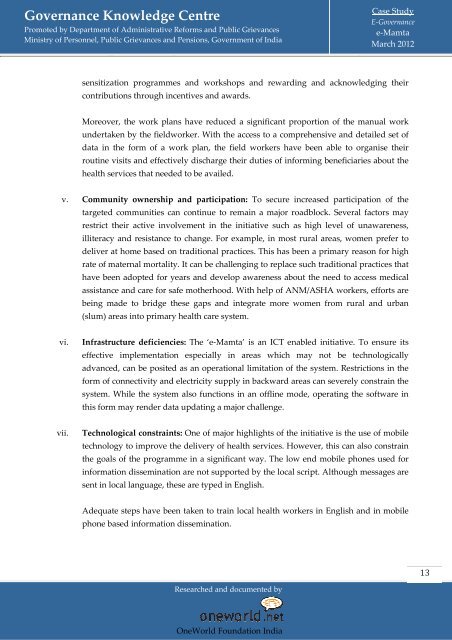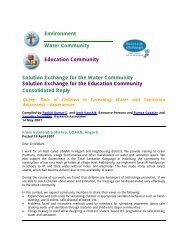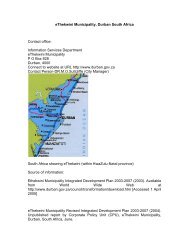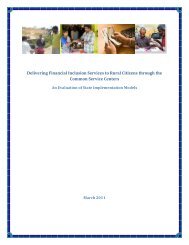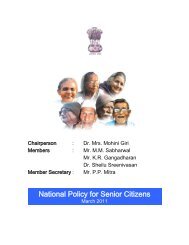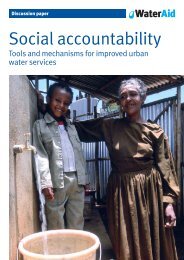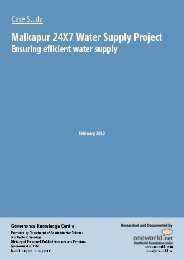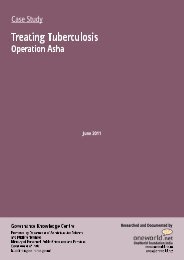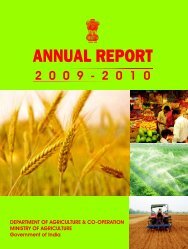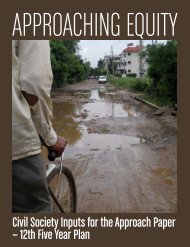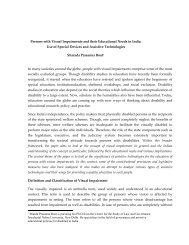See full case study - Indiagovernance.gov.in
See full case study - Indiagovernance.gov.in
See full case study - Indiagovernance.gov.in
Create successful ePaper yourself
Turn your PDF publications into a flip-book with our unique Google optimized e-Paper software.
Governance Knowledge CentrePromoted by Department of Adm<strong>in</strong>istrative Reforms and Public GrievancesM<strong>in</strong>istry of Personnel, Public Grievances and Pensions, Government of IndiaTransparency and AccountabilityCase StudyE-Governancee-MamtaMarch 2012sensitization programmes and workshops and reward<strong>in</strong>g and acknowledg<strong>in</strong>g theircontributions through <strong>in</strong>centives and awards.Moreover, the work plans have reduced a significant proportion of the manual workundertaken by the fieldworker. With the access to a comprehensive and detailed set ofdata <strong>in</strong> the form of a work plan, the field workers have been able to organise theirrout<strong>in</strong>e visits and effectively discharge their duties of <strong>in</strong>form<strong>in</strong>g beneficiaries about thehealth services that needed to be availed.v. Community ownership and participation: To secure <strong>in</strong>creased participation of thetargeted communities can cont<strong>in</strong>ue to rema<strong>in</strong> a major roadblock. Several factors mayrestrict their active <strong>in</strong>volvement <strong>in</strong> the <strong>in</strong>itiative such as high level of unawareness,illiteracy and resistance to change. For example, <strong>in</strong> most rural areas, women prefer todeliver at home based on traditional ional practices. This has been a primary reason for highrate of maternal mortality. It can be challeng<strong>in</strong>g to replace such traditional practices thathave been adopted for years and develop awareness about the need to access medicalassistance and care for safe motherhood. With help of ANM/ASHA workers, efforts arebe<strong>in</strong>g made to bridge these gaps and <strong>in</strong>tegrate more women from rural and urban(slum) areas <strong>in</strong>to primary health care system.vi.Infrastructure deficiencies: The ‘e-Mamta’ is an ICT enabled <strong>in</strong>itiative. To ensure itseffective implementation especially <strong>in</strong> areas which may not be technologicallyadvanced, can be posited as an operational limitation of the system. Restrictions <strong>in</strong> theform of connectivity and electricity supply <strong>in</strong> backward areas can severely constra<strong>in</strong> thesystem. While the system also functions <strong>in</strong> an offl<strong>in</strong>e mode, operat<strong>in</strong>g the software <strong>in</strong>this form may render data updat<strong>in</strong>g a major challenge.vii.Technological constra<strong>in</strong>ts: One of major highlights of the <strong>in</strong>itiative is the use of mobiletechnology to improve the delivery of health services. However, this can also constra<strong>in</strong>the goals of the programme <strong>in</strong> a significant way. The low end mobile phones used for<strong>in</strong>formation dissem<strong>in</strong>ation are not supported by the local script. Although messages aresent <strong>in</strong> local language, these are typed <strong>in</strong> English.Adequate steps have been taken to tra<strong>in</strong> local health workers <strong>in</strong> English and <strong>in</strong> mobilephone based <strong>in</strong>formation dissem<strong>in</strong>ation.13Researched and documented byOneWorld Foundation India


